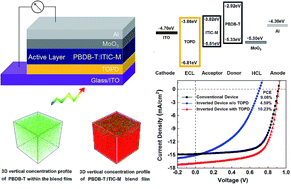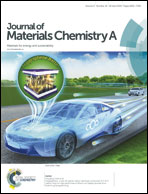Synergy of a titanium chelate electron collection layer and a vertical phase separated photoactive layer for efficient inverted polymer solar cells
Abstract
Both interfacial and photoactive layers play crucial roles in efficient polymer solar cells (PSCs). Herein, inverted PSCs with a power conversion efficiency (PCE) of 10.23% are achieved via the conjunct effect of a titanium(IV) oxide bis(2,4-pentanedionate) (TOPD) electron collection layer and a perpendicular phase separated PBDB-T:ITIC-M photoactive layer. Careful studies on the energy level and optical and morphological properties of TOPD elucidate its outstanding electron-collecting and hole-blocking function besides its highly transparent properties. Atomic force microscopy (AFM), water contact angle (WCA) measurements and time-of-flight secondary-ion mass spectroscopy (TOF-SIMS) jointly verify the vertical phase separated PBDB-T:ITIC-M photoactive layer and further present the concentration distribution of the donor and acceptor in the blend film, which ensures effective exciton dissociation and simultaneously offers independent pathways for charge transportation. The combination of their virtues facilitates the high enhancement of open circuit voltage (Voc) up to 0.21 V besides the increased short circuit density (Jsc) of 1.9 mA cm−2, leading to an encouraging PCE enhancement from 4.59% to 10.23% exceeding the traditional BHJ-PSCs with a PCE of 9.08%. Therefore, we may conclude that TOPD is a suitable electron collection layer to synergize with the vertical composition profile of photoactive blends for high performance i-PSCs.



 Please wait while we load your content...
Please wait while we load your content...